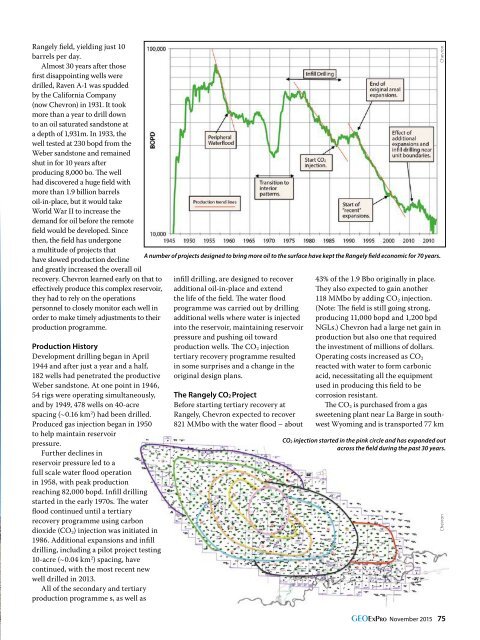Iraqi Kurdistan All in the Timing
GEO_ExPro_v12i6
GEO_ExPro_v12i6
You also want an ePaper? Increase the reach of your titles
YUMPU automatically turns print PDFs into web optimized ePapers that Google loves.
Rangely field, yield<strong>in</strong>g just 10<br />
barrels per day.<br />
Almost 30 years after those<br />
first disappo<strong>in</strong>t<strong>in</strong>g wells were<br />
drilled, Raven A-1 was spudded<br />
by <strong>the</strong> California Company<br />
(now Chevron) <strong>in</strong> 1931. It took<br />
more than a year to drill down<br />
to an oil saturated sandstone at<br />
a depth of 1,931m. In 1933, <strong>the</strong><br />
well tested at 230 bopd from <strong>the</strong><br />
Weber sandstone and rema<strong>in</strong>ed<br />
shut <strong>in</strong> for 10 years after<br />
produc<strong>in</strong>g 8,000 bo. The well<br />
had discovered a huge field with<br />
more than 1.9 billion barrels<br />
oil-<strong>in</strong>-place, but it would take<br />
World War II to <strong>in</strong>crease <strong>the</strong><br />
demand for oil before <strong>the</strong> remote<br />
field would be developed. S<strong>in</strong>ce<br />
<strong>the</strong>n, <strong>the</strong> field has undergone<br />
a multitude of projects that<br />
have slowed production decl<strong>in</strong>e<br />
and greatly <strong>in</strong>creased <strong>the</strong> overall oil<br />
recovery. Chevron learned early on that to<br />
effectively produce this complex reservoir,<br />
<strong>the</strong>y had to rely on <strong>the</strong> operations<br />
personnel to closely monitor each well <strong>in</strong><br />
order to make timely adjustments to <strong>the</strong>ir<br />
production programme.<br />
Production History<br />
Development drill<strong>in</strong>g began <strong>in</strong> April<br />
1944 and after just a year and a half,<br />
182 wells had penetrated <strong>the</strong> productive<br />
Weber sandstone. At one po<strong>in</strong>t <strong>in</strong> 1946,<br />
54 rigs were operat<strong>in</strong>g simultaneously,<br />
and by 1949, 478 wells on 40-acre<br />
spac<strong>in</strong>g (~0.16 km 2 ) had been drilled.<br />
Produced gas <strong>in</strong>jection began <strong>in</strong> 1950<br />
to help ma<strong>in</strong>ta<strong>in</strong> reservoir<br />
pressure.<br />
Fur<strong>the</strong>r decl<strong>in</strong>es <strong>in</strong><br />
reservoir pressure led to a<br />
full scale water flood operation<br />
<strong>in</strong> 1958, with peak production<br />
reach<strong>in</strong>g 82,000 bopd. Infill drill<strong>in</strong>g<br />
started <strong>in</strong> <strong>the</strong> early 1970s. The water<br />
flood cont<strong>in</strong>ued until a tertiary<br />
recovery programme us<strong>in</strong>g carbon<br />
dioxide (CO 2 ) <strong>in</strong>jection was <strong>in</strong>itiated <strong>in</strong><br />
1986. Additional expansions and <strong>in</strong>fill<br />
drill<strong>in</strong>g, <strong>in</strong>clud<strong>in</strong>g a pilot project test<strong>in</strong>g<br />
10-acre (~0.04 km 2 ) spac<strong>in</strong>g, have<br />
cont<strong>in</strong>ued, with <strong>the</strong> most recent new<br />
well drilled <strong>in</strong> 2013.<br />
<strong>All</strong> of <strong>the</strong> secondary and tertiary<br />
production programme s, as well as<br />
A number of projects designed to br<strong>in</strong>g more oil to <strong>the</strong> surface have kept <strong>the</strong> Rangely field economic for 70 years.<br />
<strong>in</strong>fill drill<strong>in</strong>g, are designed to recover<br />
additional oil-<strong>in</strong>-place and extend<br />
<strong>the</strong> life of <strong>the</strong> field. The water flood<br />
programme was carried out by drill<strong>in</strong>g<br />
additional wells where water is <strong>in</strong>jected<br />
<strong>in</strong>to <strong>the</strong> reservoir, ma<strong>in</strong>ta<strong>in</strong><strong>in</strong>g reservoir<br />
pressure and push<strong>in</strong>g oil toward<br />
production wells. The CO 2 <strong>in</strong>jection<br />
tertiary recovery programme resulted<br />
<strong>in</strong> some surprises and a change <strong>in</strong> <strong>the</strong><br />
orig<strong>in</strong>al design plans.<br />
The Rangely CO2 Project<br />
Before start<strong>in</strong>g tertiary recovery at<br />
Rangely, Chevron expected to recover<br />
821 MMbo with <strong>the</strong> water flood – about<br />
CO 2 <strong>in</strong>jection started <strong>in</strong> <strong>the</strong> p<strong>in</strong>k circle and has expanded out<br />
across <strong>the</strong> field dur<strong>in</strong>g <strong>the</strong> past 30 years.<br />
Chevron<br />
43% of <strong>the</strong> 1.9 Bbo orig<strong>in</strong>ally <strong>in</strong> place.<br />
They also expected to ga<strong>in</strong> ano<strong>the</strong>r<br />
118 MMbo by add<strong>in</strong>g CO 2 <strong>in</strong>jection.<br />
(Note: The field is still go<strong>in</strong>g strong,<br />
produc<strong>in</strong>g 11,000 bopd and 1,200 bpd<br />
NGLs.) Chevron had a large net ga<strong>in</strong> <strong>in</strong><br />
production but also one that required<br />
<strong>the</strong> <strong>in</strong>vestment of millions of dollars.<br />
Operat<strong>in</strong>g costs <strong>in</strong>creased as CO 2<br />
reacted with water to form carbonic<br />
acid, necessitat<strong>in</strong>g all <strong>the</strong> equipment<br />
used <strong>in</strong> produc<strong>in</strong>g this field to be<br />
corrosion resistant.<br />
The CO 2 is purchased from a gas<br />
sweeten<strong>in</strong>g plant near La Barge <strong>in</strong> southwest<br />
Wyom<strong>in</strong>g and is transported 77 km<br />
Chevron<br />
GEOExPro November 2015 75


